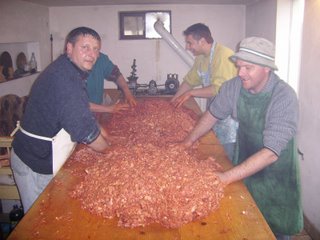It's time to get the ingredients ready ...
As you can see by the drying hot peppers
below ... it says that it's getting that time
of the year when the words 'Nădlac Sausages'
are in the air.

That is only less than 20% of the actual amount of
peppers that are needed to be dried and stored for
the upcoming sausage making season. It's really a
pretty thing to see in person.
For those of you who haven't seen a prior article
from 2006 that explains the sausage making
process just ( click here ).
In the past they explained to me that it was
more expensive to make their own sausages
as opposed to purchasing.
more expensive to make their own sausages
as opposed to purchasing.
All the ingredients are natural, as is the feed
grown organically for the pigs, the type
of meat used for making these sausages.
grown organically for the pigs, the type
of meat used for making these sausages.
That was last year, as the price of food increases,
it is actually becoming less pricey to make their
own. They grow the pigs from birth, plant the feed
and except for electricity and fuel for the tractors
and harvesters ... the farmers are almost
self-sustaining.
self-sustaining.
My sister visited last year and brought a
Nădlac sausage home with her.
As they say, a picture speaks a 1,000 words ...
so the best way to describe the delicacy that is
a Nădlac Sausage ... would be ... by a picture
a Nădlac Sausage ... would be ... by a picture
of my sister's friend Kathy below.

That picture says it all !













